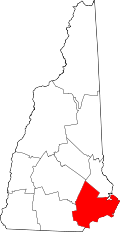Scammon Farm Historic District | |
| Location | 21–25 River Road, Stratham, New Hampshire |
|---|---|
| Coordinates | 43°00′07″N70°55′42″W / 43.00192°N 70.9284°W |
| NRHP reference No. | 100009402 [1] |
| Added to NRHP | October 10, 2023 |
Scammon Farm Historic District is a historic area in Stratham, New Hampshire. It was added to the National Register of Historic Places in October 2023. [2]
Contents
The farm, dating to 1681 and covering over 150 acres (61 ha) in the late 19th century, is located between the Squamscott River and Portsmouth Avenue (NH Route 108). [2] A farmhouse dates to 1812, two sheds date to circa 1840, and a barn dates to 1860. [2] Two other houses on the property date to 1910 and 1965. [2] A family cemetery on the property dates to at least 1840. [2]
The similarly named Scamman Farm, also located in Stratham and owned by a different branch of the family, was added to the National Register of Historic Places in 2019. [2]


